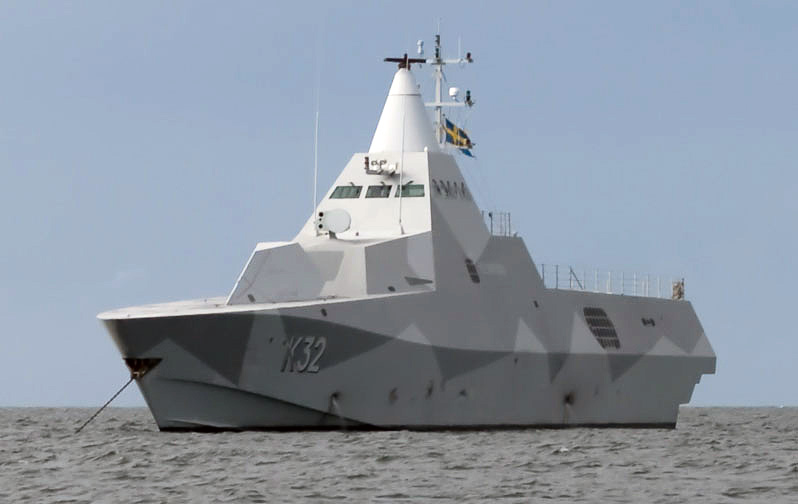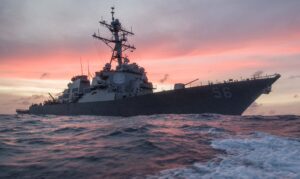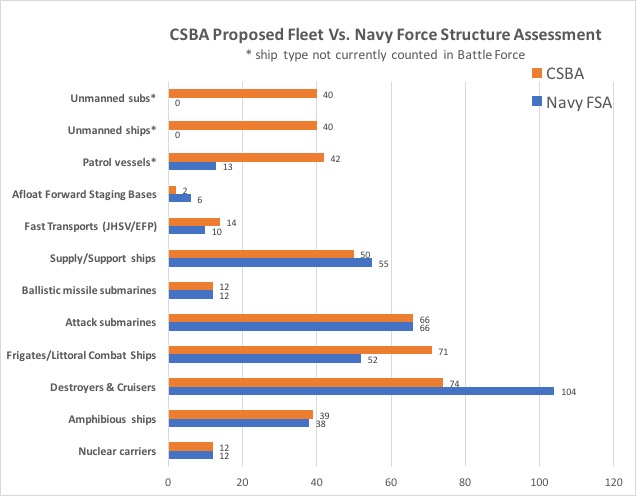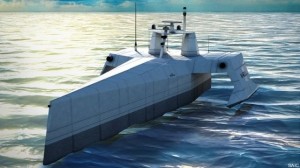Big Wars, Small Ships: CSBA’s Alternative Navy Praised By Sen. McCain
Posted on

CSBA recommends the Navy buy 40 600-ton patrol vessels, like this Swedish Visby-class corvette.
UPDATED with McCain praise WASHINGTON: The Navy needs a bigger fleet of smaller ships than envisioned in its official Force Structure Assessment, says a congressionally-chartered study from the Center for Strategic & Budgetary Assessments.
CSBA emphatically agrees with the Navy that the focus needs to shift from day-to-day counter-terrorism and presence operations to deterring (and if need be, fighting) major wars. Both plans call for a steep increase in attack submarines from 55 today to 66, along 12 nuclear-missile submarines. But CSBA recommends distinctly different surface fleet — one with many similarities to proposals from Senate Armed Services chairman John McCain.
[UPDATE: “I am particularly impressed with the comprehensiveness of the CSBA study, which should serve as the starting point for the new administration’s review of naval forces,” McCain said Friday, praising CSBA’s work out above two other “impressive” congressional chartered studies, one from thinktank MITRE and the other from a Navy team.
“It proposes necessary new strategic, operational, basing, and force structure recommendations that deserve immediate consideration by Navy leaders,” McCain said of the CSBA paper. “My recent white paper ‘Restoring American Power’ has much in common with these studies and recommendations. The question now is what tangible steps Navy leaders will take to turn these recommendations into reality.”
[Read about the Navy and MITRE alternative fleet studies]

The USS McCain (DDG 56), named after the senator’s father and grandfather, both admirals.
What Ships Count?
If you only count vessels large enough to qualify for the “battle force” under current Navy definitions, CSBA’s proposed fleet actually comes out slightly smaller than the Navy plan, at 340 ships instead of 355. (Today’s battle force is just 274 vessels). But if you also count smaller patrol craft, the Navy’s plan gives you 368 ships, CSBA’s 382. Add in seagoing unmanned vessels like DARPA’s Sea Hunter — which don’t figure in the Navy’s current calculations at all, but which make up almost a fifth of CSBA’s proposed force — the CSBA fleet grows to 462.

What’s more, the kind of ships CSBA recommends in each category is often different:
- Aircraft Carriers: While both the Navy and CSBA agree the fleet needs 12 nuclear-powered aircraft carriers` (up from 11 CVNs today), CSBA also wants to supplement the super-carriers with 10 smaller, conventionally powered “light carriers” (CVL). The CVLs would evolve from and replace current “big-deck” amphibious assault ships, sacrificing the capacity for landing craft in order to accommodate more aircraft. McCain has endorsed the light carrier idea, but the Navy and Marines are skeptical, preferring the flexibility of current big-decks.
- Cruisers & Destroyers: While the Navy calls for a whopping 104 “large surface combatants” — cruisers and destroyers — CSBA calls for only 74, and they’d all be destroyers, with no cruisers. Lead author Bryan Clark told me the larger cruisers are becoming redundant now that advanced technology, unmanned systems, and new operational concepts like “Distributed Lethality” allow smaller vessels to do more missions. For instance, instead of needing a cruiser as anti-aircraft coordinator for each carrier battle group, with destroyers in supporting roles, carrier escort could be led by destroyers backed up by CSBA’s proposed heavy frigates (below). The new frigates would also take on many other lower-threat missions, freeing up destroyers for high-intensity combat.
- Frigates & LCS: The Navy has consistently said it needs 52 “small surface combatants,” a role filled by the current, controversial Littoral Combat Ship and its future upgraded “frigate” version, all 3,000-plus-ton vessels. CSBA wants more, and bigger, small warships: 71 frigates of a new design in the 4,000-5,000 ton range. That gives room for capabilities LCS can’t fit, such as multi-purpose missile tubes (Vertical Launch Systems) for area anti-aircraft defense. These bigger frigates would play a central role in escorting aircraft carriers, smaller amphibious ships, supply convoys, unmanned vessels, and manned patrol craft. Production of the new frigate would start in ca. 2020. Sen. McCain has similarly argued we need to “get beyond” the LCS to a more capable craft “as soon as possible.”
- Patrol Vessels: Today’s Navy has 13 Cyclone-class patrol craft, small vessels at 300 tons apiece, which it doesn’t count as part of the “battle force” because they can’t cross an ocean on their own. CSBA instead envisions a larger force of larger vessels, some 40 warships in the 600-plus-ton range. Those are essentially corvettes — like the Swedish Visby, which CSBA explicitly cites as a model. Corvettes are favored by many foreign fleets but not historically by the US Navy. McCain has also suggested a new class of patrol ship of a similar size (under 800 tons), with procurement to start in 2020.
- Unmanned Vessels: While the Navy is experimenting with ever-larger Unmanned Surface Vessels (USVs) and Unmanned Underwater Vessels (UUVs), it doesn’t yet count them in its proposed battle force. CSBA, by contrast, calls for 40 “extra-large” USVs and 40 “extra-large” UUVs. While not replacing manned warships, these semi-expendable craft would play crucial roles in high-risk missions such as reconnaissance, electronic warfare (jamming tends to attract attention), and mine-sweeping. The Navy’s Expeditionary Fast Transports (formerly JHSVs) would be repurposed as motherships for unmanned craft.
[UPDATED:] “It would certainly be a big change from the past 30 years of shipbuilding. “It might also be the only way to realistically get the fleet size up any time soon,” one Hill staffer told me. “The ‘light carrier” thing would probably be the biggest change. I’m not sure what the ‘Carrier Navy’ would say about that, although there is obviously historical precedent for having carriers of varying size.”
CSBA also proposes a new way of organizing the entire fleet, splitting it into two. Most ships would be assigned to one of 10 new “Deterrence Forces,” each focused on and in part based in a specific region around the world, from the Arctic to the South China Sea. These forces would provide naval presence day-to-day and form the first line of defense in a major war. The reserve — a kind of global fire brigade — would be the US-based “Maneuver Force,” with enough high-end warships to have two nuclear-powered super-carriers and their escorts ready to deploy at any given time.

DARPA’s Sea Hunter (ACTUV) unmanned ship
How much would all this cost? CSBA estimates procurement would cost an additional $3.5 billion a year over the Obama administration’s 2017 shipbuilding plan, an 18 percent increase ($23.2 billion a year versus $19.7). Operations and maintenance (O&M) funding to train, fuel, and maintain the larger fleet would cost an additional $1.9 billion, a 14 percent increase ($16.5 billion versus $14.6). Under the Budget Control Act, these are prohibitive sums — but President Trump has promised the end of the BCA and a big boost to defense, even if he must run larger deficits to do it.
Subscribe to our newsletter
Promotions, new products and sales. Directly to your inbox.
